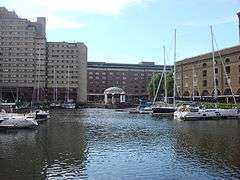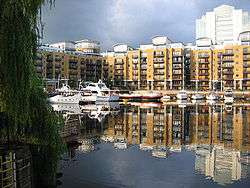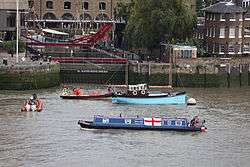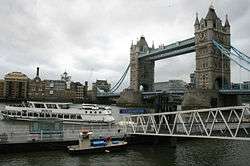St Katharine Docks
St Katharine Docks is a former dock and now a mixed-used district[1] in Central London, in the London Borough of Tower Hamlets and within the East End. It lies on the north bank of the River Thames, immediately downstream of the Tower of London and Tower Bridge. From 1828 to 1968 it was one of the commercial docks that made up the Port of London. It is in the redevelopment zone known as Docklands, and is now a popular housing and leisure complex.
| St Katharine Docks | |
|---|---|
 St Katharine Docks, London | |
 St Katharine Docks Location within Greater London | |
| London borough | |
| Ceremonial county | Greater London |
| Region | |
| Country | England |
| Sovereign state | United Kingdom |
| Post town | LONDON |
| Postcode district | EC3 |
| Dialling code | 020 |
| Police | Metropolitan |
| Fire | London |
| Ambulance | London |
| London Assembly | |
History
St Katharine Docks took their name from the former hospital of St Katharine's by the Tower, built in the 12th century, which stood on the site. An intensely built-up 23 acre (9.5 hectares) site was earmarked for redevelopment by an Act of Parliament in 1825, with construction commencing in May 1827. Some 1250 houses were demolished, together with the medieval hospital of St. Katharine. Around 11,300 inhabitants, mostly port workers crammed into unsanitary slums, lost their homes; only the property owners received compensation. The scheme was designed by engineer Thomas Telford and was his only major project in London. To create as much quayside as possible, the docks were designed in the form of two linked basins (East and West), both accessed via an entrance lock from the Thames. Steam engines designed by James Watt and Matthew Boulton kept the water level in the basins about four feet above that of the tidal river. By 1830, the docks had cost over £2 million to build.[2]
Telford aimed to minimise the amount of quayside activity and specified that the docks' warehouses (designed by the architect Philip Hardwick) be built right on the quayside so that goods could be unloaded directly into them.
The docks were officially opened on 25 October 1828. Although well used, they were not a great commercial success and were unable to accommodate large ships. They were amalgamated in 1864 with the neighbouring London Docks. In 1909, the Port of London Authority took over the management of almost all of the Thames docks, including the St Katharine.
The St Katharine Docks were badly damaged by German bombing during the Second World War. All the warehouses around the eastern basin were destroyed, and the site they had occupied remained derelict until the 1990s.[3]
 Plan drawn up for the St. Katharine Dock Company showing the street and buildings which would need to be demolished to make way for the new dock.
Plan drawn up for the St. Katharine Dock Company showing the street and buildings which would need to be demolished to make way for the new dock. Opening of St Katharine Docks, 25 October 1828
Opening of St Katharine Docks, 25 October 1828.jpg) bird's-eye view (1829)
bird's-eye view (1829)
Closure and redevelopment
Because of their very restricted capacity and inability to cope with large modern ships, the St Katharine Docks were among the first to be closed in 1968, and were sold to the Greater London Council. The site was leased to the developers Taylor Woodrow and most of the original warehouses around the western basin were demolished and replaced by modern commercial buildings in the early 1970s, beginning with the bulky Tower Hotel (designed by Renton Howard Wood Partnership; opened in September 1973)[4] on a site parallel to the river just to the east of Tower Bridge. This was followed by the World Trade Centre Building and Commodity Quay (both designed by architects Watkins Gray International). Development around the eastern basin was completed in the 1990s; the docks themselves becoming a marina. The development has often been cited as a model example of successful urban redevelopment.[3]
In 1980, a plan was approved to open a St Katharine Docks Underground station on the proposed extension of the Jubilee line. It would have been between Fenchurch Street and Wapping.[5] An eastwards extension was eventually built as part of the Jubilee line, but took a different route south of the Thames.[6] The closest stations to the Docks today are Tower Hill (tube) and Tower Gateway DLR station, both roughly equidistant from the north-west corner of the Docks.
Between 2005 and 2008 the former Danish lightship "Lightship X" (Ten) was moored on the west dock, and used as a restaurant, before returning to Denmark.[7]
The marina, including restaurants and offices, was owned by Max Property Group, operated by investor Nick Leslau, since 2011,[8] and was sold to Blackstone Group in 2014. Over the next three years, Blackstone completed a major restoration.[9] In May 2017, the company retained agents to find potential buyers for the complex; the listing price was £435m.[10] In October 2017, however, Blackstone withdrew the property from the market because bids were below the asking price.[9]
The docks today


The area now features offices, public and private housing, a large hotel, shops and restaurants, a pub (The Dickens Inn, a former brewery dating back to the 18th century), a yachting marina and other recreational facilities. It remains a popular leisure destination.
The east dock is now dominated by the City Quay residential development, comprising more than 200 privately owned flats overlooking the marina. The south side of the east dock is surrounded by the South Quay Estate which was originally social housing. The dock is still used by small to medium-sized boats on a daily basis.
The anchor from the wreck of the Dutch East Indiaman Amsterdam is on display at the entrance to the east dock.[11]
Notable boats
Notable boats regularly moored in the docks include:
- Gloriana, royal barge
- MV Havengore, former Port of London Authority hydrographic survey vessel
Several Thames sailing barges are also based in the docks.[12]
Notable residents
- David Mellor, broadcaster and former politician, and Penelope, Viscountess Cobham
- David Suchet, actor
- Jo Cox, assassinated Labour Party MP
St Katharine Pier

St. Katharine Pier is close to the St Katharine Dock, providing river transport services managed by London River Services. The main service from St Katharine Pier is a circular river cruise operated by Crown River Cruises which goes non-stop to Westminster Millennium Pier before returning via the South Bank arts centre, as well as a Westminster-Greenwich express service run by Thames River Services.[13]
The nearby Tower Millennium Pier, located on the other side of Tower Bridge, now provides the main commuter river boat services to Canary Wharf and Greenwich in the east and the West End in the west, and a fast visitor service to the London Eye.[14]
References
- "Urban Structure and Characterisation Study pages 64-75" (PDF).
- Al Naib, S.K. (July 1990). London Docklands: Past, Present and Future. University of East London. p. 11.
- Craig, Charles; Diprose, Graham; Ellmers, Mike Seaborne; with Chris; Werner, Alex (2009). London's Changing Riverscape: Panoramas from London Bridge to Greenwich. London: Frances Lincoln. p. 21. ISBN 9780711229419.
- "Tower Hotel London". J Lyons & Co. Retrieved 4 February 2016.
- Horne, Mike (2000). The Jubilee Line. Capital Transport. pp. 50–52. ISBN 1-85414-220-8.
- Horne, Mike (2000). The Jubilee Line. Capital Transport. p. 57. ISBN 1-85414-220-8.
- "Fyrskib Nr. X – Lightship Ten". feuerschiffseite.de. Retrieved 3 May 2013.
- Kollewe, Julia (28 June 2011). "Secret millionaire Nick Leslau buys St Katharine Docks". the Guardian.
- FINNEY, ELIZABETH (5 April 2017). "Renovation of St Katharine Docks in London complete". Boat International Media.
- Evans, Judith (10 May 2017). "London's St Katharine Docks up for sale". Financial Times.
- "Amsterdam Anchor St Katherine Docks London England". waymarking.com. Retrieved 26 August 2014.
- "Sailing Barge Association – where to see Thames Barges". sailingbargeassociation.co.uk. Archived from the original on 17 July 2015.
- Transport for London (2008). "Boats from St Katharine's Pier" (PDF). Retrieved 16 May 2008.
- Transport for London (2008). "Boats from Tower Millennium Pier" (PDF). Retrieved 16 May 2008.
External links
| Wikimedia Commons has media related to St Katharine Docks. |